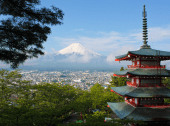
Tucked away in the heart of Ibaraki Prefecture, Japan, stands the majestic Mt. Tsukuba. Unlike the more famous Mt. Fuji, Mt. Tsukuba, with its twin peaks, offers a unique charm that beckons hikers from all corners. As I embarked on this journey, I quickly understood why it’s known as “The Purple Mountain” – a testament to its breathtaking beauty.
Accessible from Tokyo, a 45-minute train ride will get you to Tsukuba Station. From there, a direct bus or a rental car can lead you to the mountain’s base. Spring (March to May) and Autumn (September to November) are ideal for hiking in Mt. Tsukuba. The weather is pleasant, and the scenery, whether it’s cherry blossoms or autumn leaves, is stunning.
Jump to
The Journey to Mt. Tsukuba from Tokyo
Beyond the Hike: Onsen Experience
Packing Essentials
Embarking on a hike requires careful preparation, especially regarding what you bring along. Here’s a list of essentials that you should pack for your Mt. Tsukuba adventure:
1. Comfortable Hiking Shoes 🥾
– Importance: A good pair of hiking shoes is crucial for both comfort and safety. They should provide ample support, grip, and protection against rough terrain.
– Tips: Ensure your shoes are well broken in before the hike to avoid blisters. Waterproof or water-resistant shoes are recommended, especially if you’re hiking in damp conditions.
2. Weather-Appropriate Clothing 🎽
– Layering: Dress in layers to easily adjust to changing temperatures. Include a moisture-wicking base layer, an insulating layer, and a waterproof outer layer.
– Additional Items: Depending on the season, pack a hat and gloves for colder weather or a sun hat and sunglasses for sunny days.
3. Water and Snacks 💦🥜
– Hydration: Carry enough water for the hike. A general rule is about half a litre per hour of moderate activity in moderate temperatures.
– Nutrition: Pack energy-boosting snacks like nuts, trail mix, energy bars, or fruit. They should be lightweight, nutritious, and high in energy.
4. First-Aid Kit ⛑️
– Contents: Your kit should include adhesive bandages, antiseptic wipes, blister treatments, gauze pads, adhesive tape, pain relief medication, and any personal medications.
– Extras: Consider adding items like insect repellent, sunblock, and a small whistle for emergencies.
5. Camera to Capture Scenic Vistas 📸
– Choice: A lightweight, durable camera is ideal. If you’re using your phone, ensure it’s fully charged. A portable charger can be a handy addition.
Packing the right items can make a significant difference in your hiking experience. With this comprehensive packing list, you’re ready to tackle the trails of Mount Tsukuba and enjoy a safe and memorable adventure!
The Journey to Mt. Tsukuba from Tokyo
When planning your hike to Mt. Tsukuba, it’s important to consider the various transportation options available, their costs, and the convenience they offer. Below is the breakdown of the route and fares if you are going from Tokyo!
From Akihabara to Tsukuba
1. By Train:
– Route: Take the Tsukuba Express from Akihabara Station to Tsukuba Station. The trip will take you 45 minutes until you reach Tsukuba Station
– Cost: A one-way ticket costs approximately 1,150 to 1,250 yen, depending on the type of train (rapid or semi-rapid)
2. Other Options:
– By Bus: Direct highway buses are available from Tokyo Station or Tokyo’s Yaesu South Exit to Tsukuba Center. While this is a viable option, it’s less convenient for those starting from Akihabara and a one-way ticket costs approximately 1,200 yen.
– Driving: Renting a car and driving to Tsukuba is another option, offering more flexibility. The trip takes about 1.5 to 2 hours. Rental and fuel costs will vary.
From Tsukuba Station to Mt. Tsukuba
1. Bus to Mt. Tsukuba:
– Route:From Tsukuba Station, take a bus to Tsukuba-san Jinja Iriguchi (Tsukuba Shrine Entrance).
– Duration: The bus ride takes about 40 minutes.
– Cost: A round-trip bus fare is around 1,100 yen.
Total Estimated Transportation Cost
– Round-Trip Train Fare: Approximately 2,300 to 2,500 yen (Akihabara ↔ Tsukuba)
– Round-Trip Bus Fare: About 1,100 yen (Tsukuba Station ↔ Mt. Tsukuba)
– Total: Expect to spend around 3,400 to 3,600 yen for the round-trip journey
Therefore, loading your IC card with around 6,000 yen would comfortably cover your transportation costs to Mt. Tsukuba and back, including any additional small expenses you might encounter along the way.
The Trails Waiting For You
Mt. Tsukuba is unique with its two peaks: Nantai and Nyotai. The panoramic views from both peaks are spectacular, offering a vista of the Kanto plain and even Tokyo Skytree on clear days. Along the way, the lush flora and occasional wildlife sightings add to the thrill.
Each trail also offers a distinct experience. The Miyukigahara trail, ideal for beginners, leads to Nantai Peak, while the more challenging Shirakumo Bai trail takes you to Nyotai Peak.
Nantai Peak: The Accessible Ascent

- Height: Nantai, the slightly shorter of the two, stands at 871 meters.
- Trail Characteristics: The trail to Nantai, primarily the Miyukigahara trail, is well-maintained and less strenuous, making it ideal for beginners or families. The path is often shaded, winding through serene forested areas.
- Attractions Along the Way: As you ascend, you’ll encounter the Tsukuba Shrine, one of the oldest shrines in Japan, nestled halfway up the mountain. This adds a cultural element to your hike.
- View from the Summit: The summit offers a spectacular view of the Kanto Plain. You can see landmarks like Tokyo Skytree in the distance on clear days.
Nyotai Peak: The Challenge for the Avid Hiker
- Height: Nyotai peak rises slightly higher, reaching 877 meters.
- Trail Characteristics: The Shirakumo Bai trail to Nyotai is more challenging, with steeper inclines and rugged terrain. It’s a rewarding choice for those seeking a more strenuous hike.
- Flora and Fauna: This trail is rich in biodiversity. You might spot unique bird species and an array of seasonal wildflowers.
- View from the Summit: The summit of Nyotai offers a different perspective, with breathtaking views.
The Link Between the Peaks

- Connecting Path: A well-trodden path links the two peaks, allowing hikers to experience both in a single visit. The journey between the two summits is an adventure in itself, with changing landscapes and occasional wildlife sightings.
- Cable Cars and Ropeways: For those who prefer a less strenuous approach, cable cars and ropeways are available to reach either peak, providing an easier alternative with stunning aerial views of the surrounding landscape.
My Personal Journey

As I ascended, the verdant foliage and the chirping of birds were my companions. The challenge of the Shirakumo Bai trail tested my limits, but the sense of accomplishment upon reaching Nyotai Peak was unparalleled. Each turn offered a new, beautiful canvas of nature. My hike up Mt. Tsukuba’s Shirakumo Bai trail was really special because it was raining. The light rain made everything look different. The trees and plants looked greener and the raindrops made a nice sound as they hit the leaves. It felt like being in a different world, with everything fresh and cool because of the rain.
The trail was more fun and a bit tricky in the rain. The rocky parts were slippery, so I had to be careful not to slip. The paths with leaves were kind of muddy, but it was fun to walk through the small puddles. The rain made the hike feel like a real adventure like I was exploring some secret place.
Getting to the top, Nyotai Peak, was awesome, especially with the rain. The rain made everything look misty and kind of magical. I couldn’t see as far as on a clear day, but the foggy view had its own cool look. Standing there with the rain around me felt really peaceful. It was like the rain made everything calm and quiet.
Walking back down the mountain in the rain was nice. The path looked a bit different now that it was wet, and I saw things I didn’t notice on the way up. The rain kept falling gently, which made the whole hike feel relaxed. It was just cool to be out there in nature, walking in the rain, and enjoying how different and peaceful everything was.
The whole experience of hiking Mt. Tsukuba in the rain was made possible thanks to the Coto Cultural Course. Their guidance and support turned what could have been a regular hike into an unforgettable adventure.
Beyond the Hike: Onsen Experience

Tsukuba offers more than just hiking. You can relax in one of the local onsens (hot springs) after your hike! I visited Tsukuba-no-yu (筑波山温泉つくばの湯) after my hike, which is about 10 minutes walk from Tsukuba Shrine Entrance.
– Location: Conveniently situated, Tsukuba-no-yu Onsen is an easy stop for hikers coming from Mt. Tsukuba. The short 10 minutes walk from the shrine entrance is a gentle stroll, transitioning from the exhilaration of the hike to the calm of the onsen. https://maps.app.goo.gl/MMYYkAVXQnc159gZ8?g_st=ic
– Facilities: The onsen features various baths, including open-air baths that integrate its natural surroundings. The facilities are well-maintained and clean, offering a tranquil environment. Rest areas are also available for visitors to relax and soak in the peaceful atmosphere.
– Additional Amenities: Besides the baths, the onsen offer other services like massages, dining options, and possibly accommodations, making it a comprehensive spot for relaxation.
– Pricing: The entrance fee to Tsukuba-no-yu onsen is quite reasonable. On weekdays, the price is 1,100 yen, while on weekends and holidays, it goes up slightly to 1,300 yen.
Join Our Culture Course to Have this Unique Experience!
I was able to enjoy this unique hiking & onsen experience at Mt. Tsukuba thanks to Coto’s Culture Course. This course played a crucial role in deepening my understanding and appreciation of Japanese culture and the natural beauty of the area.
- Guided Exploration: Through the Coto Cultural Course, the hike became more than just a physical activity. It was an educational journey, filled with fascinating facts about the local flora, fauna, and history of Mt. Tsukuba.
- Cultural Insights: The course also offered valuable lessons in Japanese traditions, including onsen etiquette and local culinary delights, enriching the overall experience.
- Connecting with Nature and Culture: The insights provided by the course allowed for a deeper connection with the environment and a greater appreciation for the cultural practices that are integral to Japanese life.
Coto’s Culture Course is a 4-week add-on course that will allow you to experience both traditional and modern Japanese cultures on top of your Japanese studies with 8 to 9 events lined up per month! We have other unique and exciting events like Karaoke, Taiko, Iaido, Shamisen, and many more! Check out our page for more information!

















